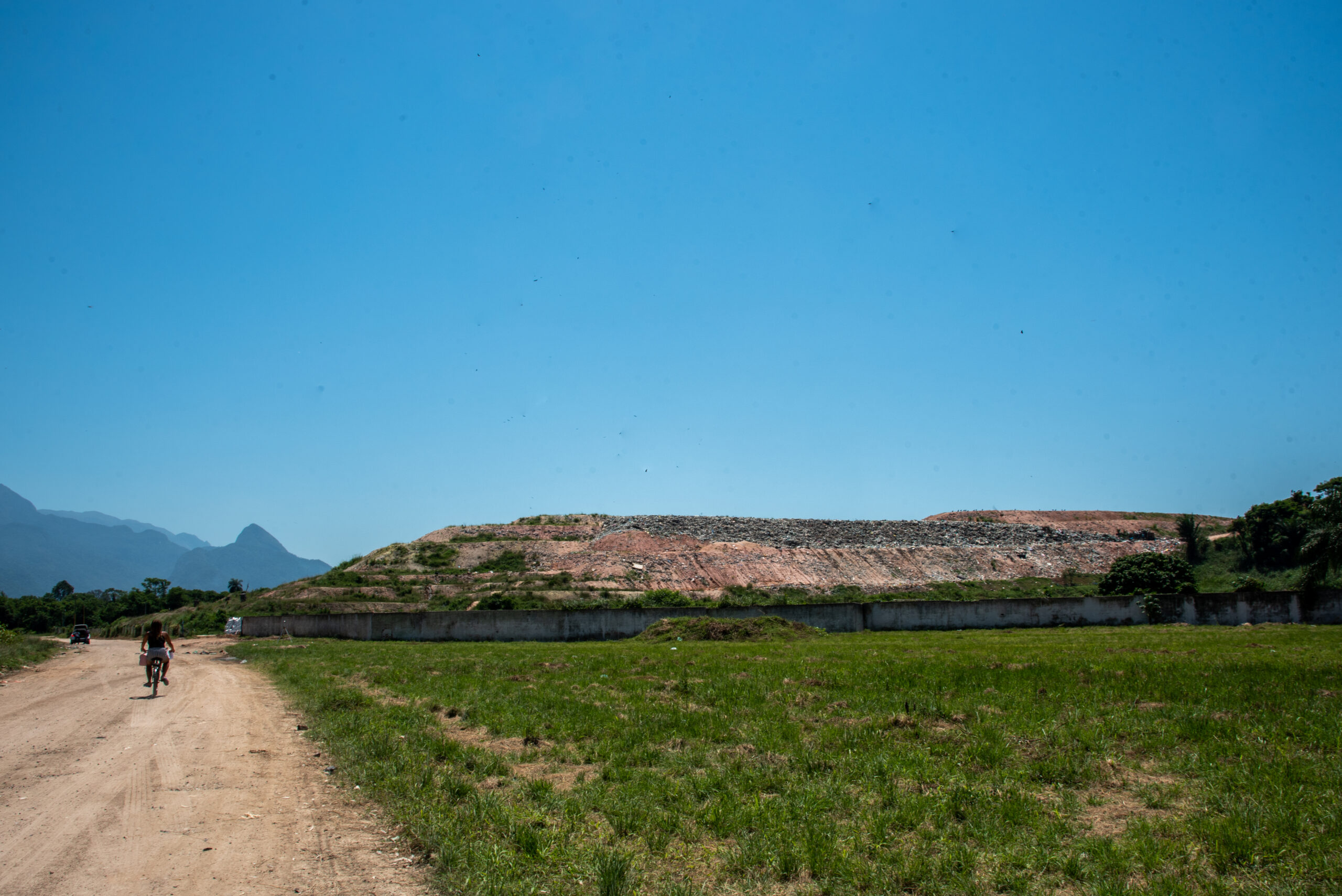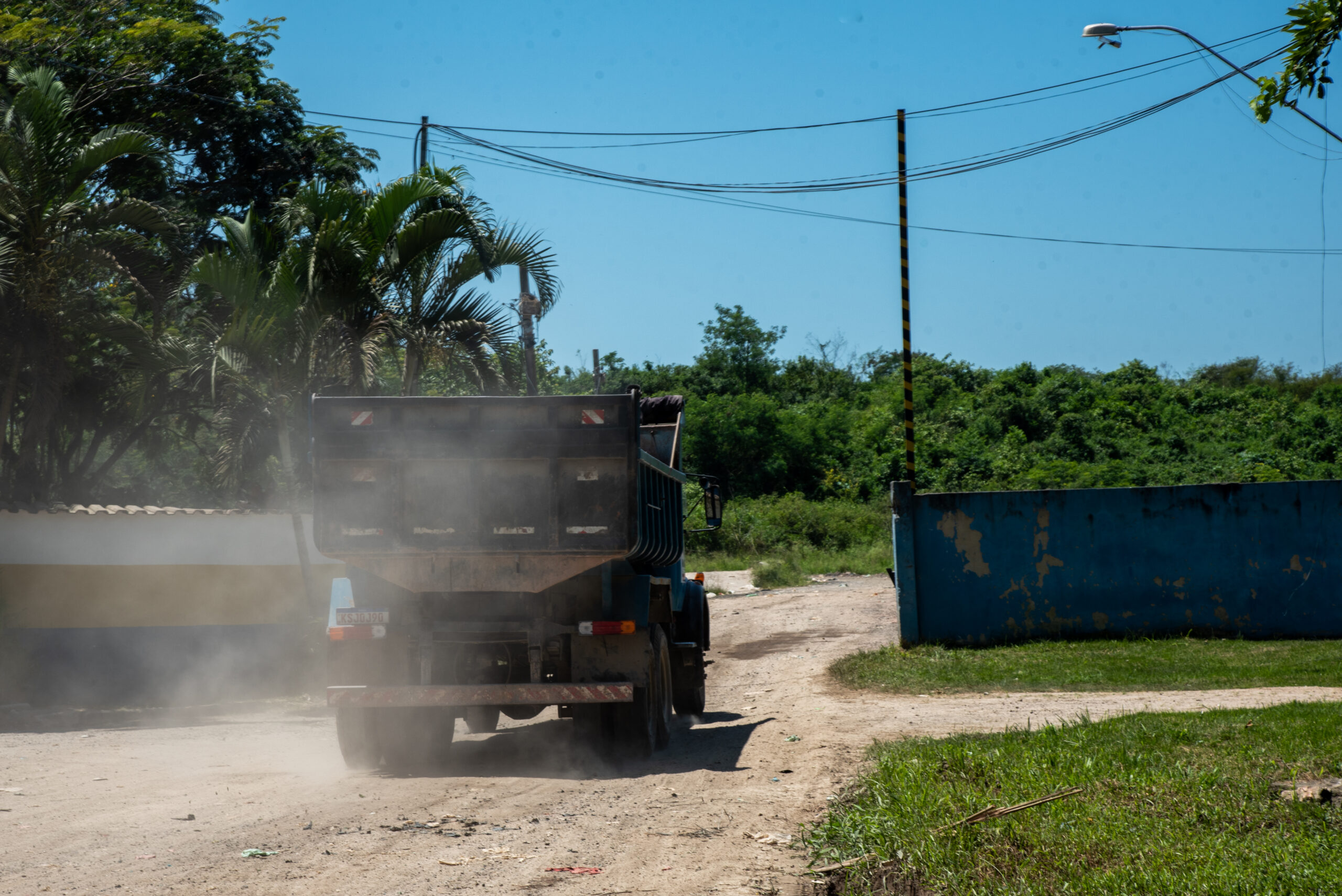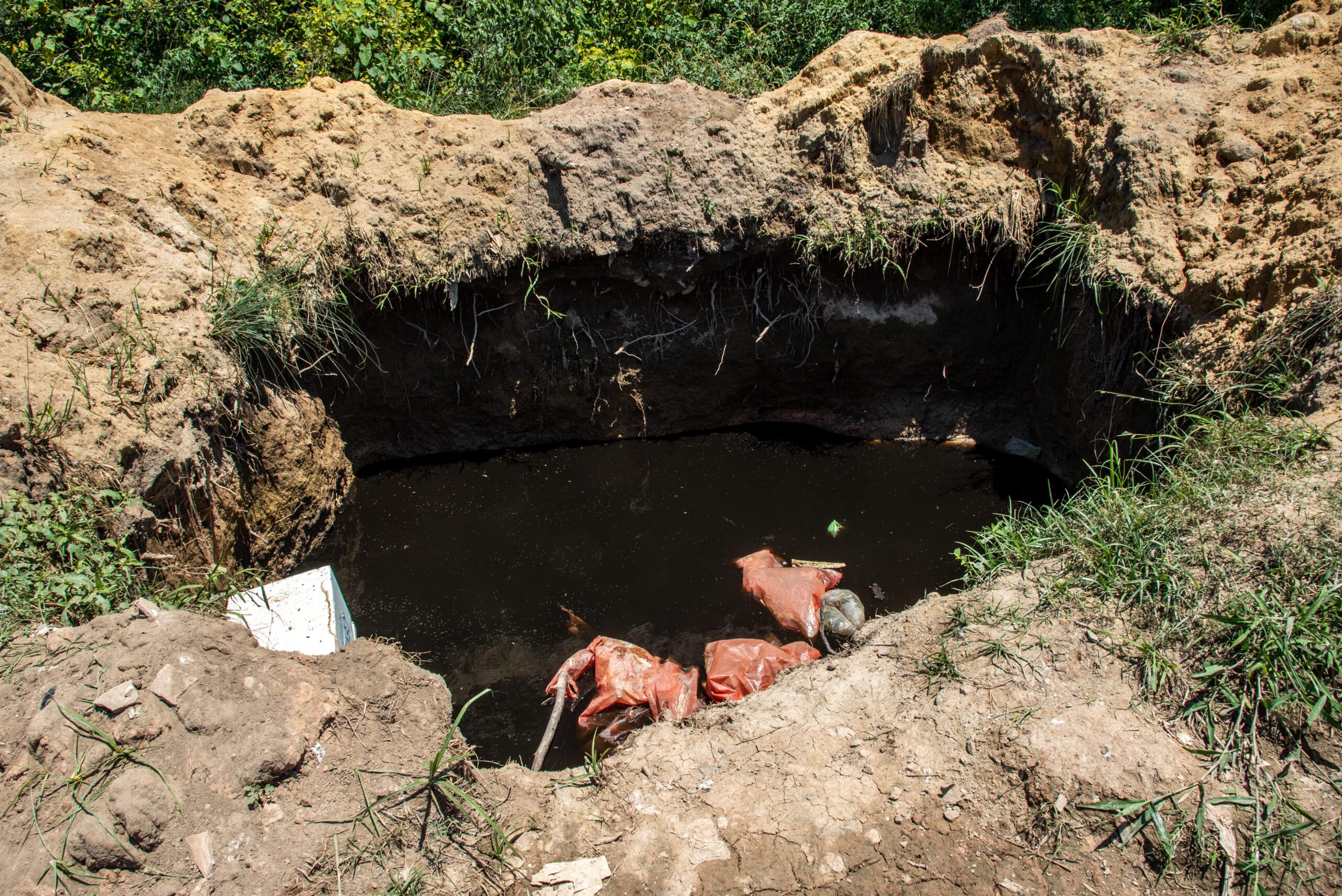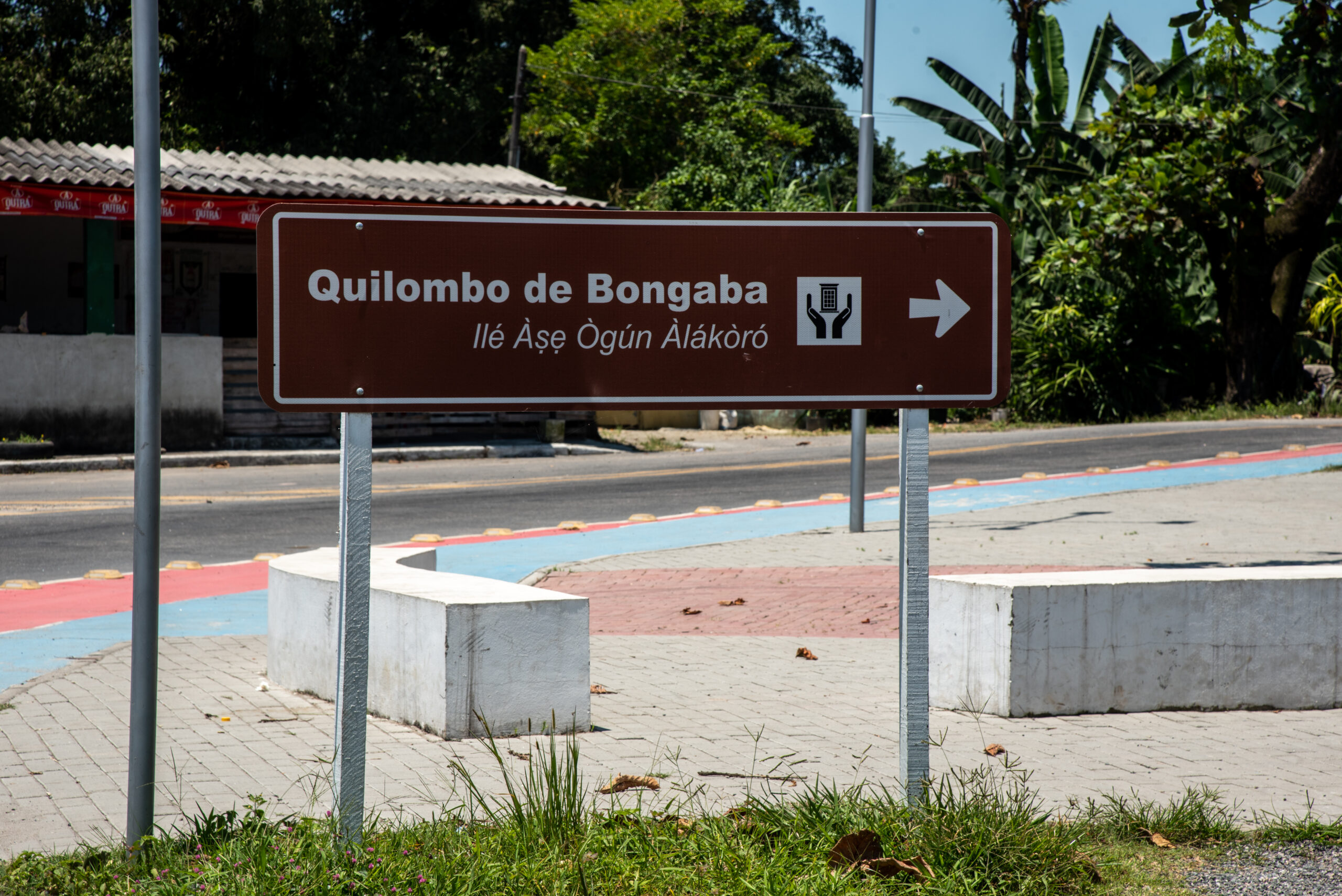
Clique aqui para Português
Garbage Policy: Profit and Environmental Disaster
The issue of garbage in Magé, a municipality in Greater Rio de Janeiro’s Baixada Fluminense region, has been a longstanding concern for residents and socio-environmental activists. According to the Magé Climate Forum, the municipality is being targeted through political maneuvers to become the final dumping ground for solid waste generated by other cities in the metropolitan area. Besides the inappropriate location of the Bongaba waste site, posing a high risk of soil and water contamination in the region, including Guanabara Bay, there is an additional problematic layer—the territory is part of a quilombo. Quilombos are communities given special status as places of preserved Afro-Brazilian ancestry dating back to the days of slavery. In other words, this environmental crime is also a case of environmental racism.
Upon visiting Bongaba, we spoke to three members of the Magé Climate Forum: Anderson Ribeiro, a lawyer and president of the Brazilian Bar Association Human Rights Commission (OAB) Magé-Guapimirim Chapter, and coordinator of the +NÓS Popular Education Movement; William Jefferson, a biologist engaged in popular education, anti-racist and socio-environmental activism; and Lyvia Leite, a social scientist and popular educator at the +NÓS college entrance prep course, specializing in social projects and public policies. Leite is actively involved in agroecology, food security, and grassroots rural farming.

I waited for the members of the Magé Climate Forum to arrive for our interview. The Bongaba dump receives waste from the municipality and is situated in a region that provides access to Piabetá, one of the municipality’s key neighborhoods. From our meeting point, a conspicuous mountain of garbage can be seen, piled up within an area surrounded by a low wall although the soil in the area was never prepared to receive this waste heap. The movement of trucks was intense—within an hour and a half, at least twenty vehicles came and left the dump.
We started the interview and I asked permission to record. Tensions were high, as, in a recent report, the Climate Forum group disclosed it had experienced political intimidation from the dump manager and Magé’s Secretary of the Environment, Boneco Mania, who sought to prevent the interview. In this attempt, he presented reporters with outdated information about Bongaba, even stating that Magé would not receive garbage from other cities and that the dump would close this month (December 2023). The aim of this interruption was to stifle residents’ complaints to the press at the time. Despite Boneco Mania’s promises, however, now plainly in December, there is no sign the municipality is halting the dump’s activities.
Environmental organizer and lawyer Anderson Ribeiro mentioned that in 2021, a change was made to the municipality’s Organic Law to allow the city to receive waste from other municipalities, garnering significant media attention. He asserts that, in its current state, the dump lacks the capacity to handle garbage from other municipalities, and struggles even to manage the waste generated by Magé itself.
Anderson continued this historical overview, mentioning that, after significant pressure and complaints from residents, in 2013, the possibility of transforming the Bongaba dump into a large, regulated landfill was on the table. According to the lawyer, the Magé-Guapimirim OAB at the time took legal action to prevent this transformation. In response, the Rio de Janeiro Court of Justice (TJRJ) granted the order’s request and annulled the environmental license for the landfill’s construction. Consequently, not only did the dump persist, but it also expanded.

In Magé, Environmental Racism as Law and Public Policy
However, on September 29, 2023, the new Municipal Law No. 2841/2023, authored by Mayor Renato Cozzolino, granted Magé the authority to provide concessions to other municipalities for waste disposal. Under the law approved by City Council, the specific municipalities from which the waste would originate are left unspecified.
Coincidentally, six days after the law was enacted, a public hearing was organized to introduce the Metropolitan Plan for Integrated Solid Waste Management (PMetGIRS). The plan aims to address the solid waste management needs of the 22 municipalities that make up Rio’s Greater Metropolitan Region. The event was hosted by the Rio Metrópole Institute, established to represent the executive power of the state of Rio de Janeiro in the Metropolitan Region. This body aims to oversee the creation of consortia dedicated to solid waste management. During this event, Magé was identified to receive approximately 2.5 tons of garbage daily from cities like Duque de Caxias, Petrópolis, and Teresópolis.
“This dump [in Bongaba] is scheduled to close in December. The State Institute for the Environment (INEA) issued a notification, but INEA has done this several times before… The environmental secretary, on the day he came here, said [it] was going to close in December. However… if it is indeed closing, the garbage will have to be taken elsewhere. And, so far, we’re not aware of any other site… It appears that the study conducted by the Rio Metrópole Institute is geared towards establishing the new waste site. If they’re saying that they’re going to close this dump in December, where will the garbage go?… At the same time that the law was passed [in Magé], we don’t believe it’s a coincidence… [we believe that it’s] a political arrangement between the municipality and the state to redirect the garbage here.” — Anderson Ribeiro

When asked if they believe in the possibility of establishing a new waste site or landfill elsewhere in Magé, the members of the Magé Climate Forum said they do not. According to them, it is clear that this dump is not going to close. Going even further, they believe that illegal waste disposal will increase in Bongaba. This is mainly due to the logistical ease of truck access to the site and the uncertainty surrounding the destination of waste from nearby cities.
“We believe that it will stay right here: first of all, because no one talks about an alternative location… and for this other place [to be chosen], we have to consider the logistical aspects… having the dump here is convenient because it’s in the middle of the road, with easy access connecting the cities involved in the process: Caxias is next door, Teresópolis is right there, and we’re in the middle… So, logistically, it is strategic to dump [the garbage] here… And I remember that during the dispute, in 2021, they said the dump wouldn’t be here. Then there was a struggle over where it would be located and no ideal location was found… I believe the idea is to keep it here and turn it into a landfill if they can… Despite this being quilombola territory, this section [of the dump] is sparsely populated. The densely populated area is more on the other side [of the road]… There are many conveniences here [for governments and companies that use the dump], so it will probably stay as it is.” — William Jefferson
The area where the dump is located is in close proximity to the Quilombo de Bongaba. Given the proximity of this quilombola area, it is difficult not to associate the selection of the dumping grounds with environmental racism.
“We were conducting climate leadership training against environmental racism a week before this news from the Rio Metrópole Institute broke… The training took place in Quilombo de Bongaba, aiming to map locations of environmental injustice that experience environmental racism along the short route between the quilombo and the dump.
I believe the Forum’s work is to move in the direction of sensitizing people genuinely interested in working in the area to advocate for [solutions] to these [socio-environmental] issues. Therefore, I think we managed, in a way, to do a good job in organizing this movement against the dump. A week before, we were here with 15 leaders [already thinking about the issue].” — Lyvia Leite

Furthermore, members of the Forum highlight that, since the signing of the law, it has become even more difficult to follow the process. Its implementation will have a major impact on the community and, therefore, the information should be public and easily accessible, as required by law. However, everything has been done in a non-transparent manner by public authorities. This lack of transparency makes it impossible to plan the next steps to be taken by social movements interested in containing the socio-environmental and racial disaster in Magé.
Socio-environmental Impacts of the Expansion of the Bongaba Dump
On the Magé Climate Forum’s social media, there are posts outlining the key issues that may intensify if the city becomes the dumping ground for waste from various municipalities in the Metropolitan Region. The primary concern is the potential overload of waste, making it challenging for local collection services to manage the city’s own garbage. This could lead to garbage accumulation on Magé’s streets, creating unhealthy environments, as seen in past instances.
With the rising waste disposal in the municipality of Magé, the Forum is concerned about a potential surge in diseases among the population, especially those living near the dump. These could include respiratory infections, skin diseases, foodborn illnesses, dengue, Zika, and Leptospirosis. There is also apprehension about waterborne diseases acquired through the use of contaminated water. Additionally, there’s the worry of an increase in the spread of diseases resulting from direct contact with garbage, particularly affecting children, workers, and recyclables collectors at the Bongaba dump.
Water pollution is a grim reality in this scenario, given that the Bongaba dump is surrounded by rivers and other bodies of water. All this water, polluted by garbage and leachate from the rivers, flows into Guanabara Bay, contaminating the region’s groundwater. The risk to biodiversity is serious and could result in the decline of species.
In this way, the Magé Climate Forum alerts that the escalating dumping of garbage and toxic waste in the municipality will impact the quality of life locally and in the metropolitan region at large. It will affect the quality of water, air, health, and livelihood of the population, local fauna and flora, and Guanabara Bay. There will be an increase in polluted areas infested by vectors, unpleasant odors, and truck traffic, which also contributes to air pollution and road degradation, in addition to disturbing the peace of a mostly rural region. Being in a quilombola area on the shores of Guanabara Bay only exacerbates everything and highlights the environmental racism of this criminal endeavor.
About the author and photographer: Bárbara Dias was born and raised in Bangu, in Rio’s West Zone. She has a degree in Biological Sciences, a master’s in Environmental Education, and has been a public school teacher since 2006. She is a photojournalist and also works with documentary photography. She is a popular communicator for Núcleo Piratininga de Comunicação (NPC) and co-founder of Coletivo Fotoguerrilha.
